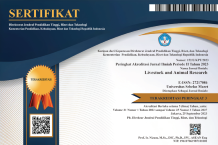Kekerabatan merpati hias (Columba livia) dilihat dari profil protein darah
Abstract
Objective: The purpose of this study was to predict the kinship of ornamental pigeons based on blood proteins.
Methods: The research method used is exploratory descriptive with a laboratory observation-based approach. Research procedures include: Blood Sampling, Blood Protein Isolation, Purification, Measurement of concentration with a nanodrop spectrophotometer and Electrophoresis. Data analysis includes: Protein Band Profile and Determination of Protein Molecular Weight with RF formula and Relationship with MVSP version 3.22 program.
Results: The protein profile in the plasma of ornamental pigeons is different from one type of pigeon to another. some of the protein appears in the ornamental pigeon species but does not appear in other breeds. Likewise with the target protein to be analyzed, some are expressed and some are not expressed in ornamental pigeons. Results based on the analysis of protein profiles and dendograms of the four specific proteins (hemoglobin, transferrin, posttransferrin, and immunoglobulin) contained in erythrocytes and blood plasma, it can be seen that there are two clusters. Cluster 1 is occupied by varieties of ornamental pigeons Moven and cluster 2 is occupied by varieties of ornamental pigeons Lahore, American fantail, Vienna, Indian Fantail, King, Capucine, Gondok and Modena.
Conclusions: The results of the ornamental pigeon kinship prediction based on blood protein showed that each variety had different kinship relationships. King, Capucine, Gondok and Modena pigeons have the closest relationship, and Moven pigeons have the most distant relationship from the researched ornamental pigeons.
Keywords
Full Text:
PDF (Bahasa Indonesia)References
Nurdiyanto, E. dan H. N. S. Yanti. 2019. Pengetahuan ekologi masyarakat banyumas mengenai penamaan burung merpati. Prosiding Seminar Nasional dan Call for Papers ”Pengembangan sumber daya pedesaan dan kearifan lokal berkelanjutan IX”. 9(1).
Kabir, A. 2019. Analyses on Colour, Structure, and Behaviour of Fancy Pigeons. EC Vet. Sci. 5(1): 01-04.
Szmukier, S. M., K. Andres, K. Piorkowska, and R. K. Molik. 2021. Low diversity of mitochondrial DNA in fancy pigeons (Columba livia) revealed by partial Dloop sequencing. Anim. Genetics. 52(3):382. Doi: 10.1111/age.13066
ELFP. 2012. EE-List of The Breeds of Fancy Pigeons [Internet]. [cited 2014 October 5]. Available from: www.entente-ee.com.
Hastarina, R. 2016. Keragaman Genetik Burung Maleo (Macrocephalon maleo) Berdasarkan Polimorfisme Protein Darah. J. Agrisains. 17(2) : 92-100.
Dharmayanthi, B. A., A. Muchsinin, A. Pulungan, and A. S. M. Zein. 2021. Diversitas genetika dan identifikasi jenis kelamin burung pelikan (Pelecanus conspicillatus Temminck, 1824) di Penangkaran Taman Margasatwa Ragunan Jakarta. Jurnal Biologi Indonesia. 17(2): 105-114. Doi: 10.47349/jbi/ 17022021/105
Suci, M. D., U. N. Nuha, and Suryahadi. 2019. Pemberian ekstrak daun kemuning (Murraya paniculata (L.) Jack) dalam air minum terhadap performa dan kualitas fisik telur Puyuh Malon. Jurnal Ilmu Nutrisi dan Teknologi Pakan. 17(3): 73-77. Doi: doi.org/10.29244/jintp.17.3.73-77
Ismoyowati. 2008. Kajian deteksi produksi telur itik tegal melalui polimorfisme protein darah. Anim. Prod. 10(2):122-128.
Yuwono. 2008. Biologi molekuler. Jakarta: Erlangga
Warwick, E. J., J. M. Astuti, and W. Hardosubroto. 1990. Pemuliaan Ternak. Yogyakarta: Gadjah Mada University Press.
Rahayu, S. E. 1998. Pengkajian hubungan kekerabatan tujuh jenis burung merpati familia columbidae berdasarkan protein plasma darah. Chimera 3(5)
Rahayu, S. E., Susilowati, dan R. I. Sri. 2006. Kajian profil protein plasma darah tiga jenis burung merpati (Merpati Pos, Kipas dan Pedaging) dalam rangka konservasi variasi genetic. MIPA. 35(2).
Pratiwi. 2001. Mengenal metode elektroforesis. Oseana. 26(1): 25 – 31.
Fatchiyah., L. A. Estri, W. Sri, dan R. Sri. 2011. Biologi Molekuler Prinsip Dasar Analisis. Jakarta: Erlangga.
Sari, M. L., R. N. Ronny, H. Peni, dan Chairun, N. 2011. Polimorfiems Proteisn Darah Itik Pegagan dengan Metode PAGE. Agripet. 11(2).
Chahal, S. M. S., dan B. Rupinder. 2005. Haemoglobin variants in North Indian Populations. Anthropologist. 7(1): 1-6. Doi: doi.org/10.1080/09720073.2005.11890875
Mordacq, J. C and Roberta, W. E. 1994. Poly acrylamide gel electrophoresis (PAGE) of blood proteins. USA: Universitas Northwestern.
Arefanian, H. and M. Djalali. 2002. A new protocol for isolation and purification of transferrin from human serum. Iran. J. Public Health. 31(1-2): 15-18.
Guyton, A. C., J. E. Hall. 2006. Textbook of Medical Physiology. 11th edition. Philadel phia: Elsevier Saunders.
Ross. M. H. and P. M. D. Wojciech. 2011. Histology A Text and Atlas. USA: West Camden Street Baltimore.
Faruque, M. O. 2007. The Genetic Diversity of Bangladesh Buffaloes. Ital. J. Anim. Sci. 6: 349-352. Doi: doi.org/10.4081/ijas.2007.s2.349
Caraviello, D. Z. 2004. Croosbreesing dairy cattle. Reproduction and Genetics. 610: 1-5.
Noor, R. R. 2008. Genetika Ternak. Jakarta: Penebar Swadaya.
Refbacks
- There are currently no refbacks.










